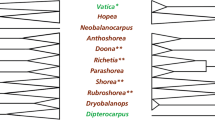Abstract
Over a ten year period, 1988–1998, over 300 woodlands were visited throughout Scotland and 2061 records of saproxylic Diptera obtained. Of these 1574 were records of early stages; 258 species in 32 families were encountered; 206 species were reared of which 53 were red-listed, 9 were new to Britain and 10 were new to science. Most records came from native boreal trees such as Betula pubescens, Pinus sylvestris and Populus tremula. However, few saproxylic Diptera were specific to tree species, exceptions were 6 red-listed species associated with P. tremula and 5 red-listed species with P. sylvestris. In contrast, most saproxylic Diptera were specific to microhabitat or breeding site. The most important microhabitats were decaying sap under bark and decaying sapwood. Most red-listed species are restricted to Strathspey and north-east Scotland where relatively large stands of native boreal trees exist.
Similar content being viewed by others
References
Chandler, P.J. (1999) Creagdhubhia mallochorum gen. and sp. n. (Diptera: Mycetophilidae), a remarkable new Scottish gnat with a discussion of its relationships. British Jounal of Entomology and Natural History 12, 121-34.
Essen, P.A, Ehnstrom, B., Ericson, L. and Sjoberg, K. (1992) Boreal forests, the focal habitats of Fennoscandia. In Ecological principles of nature conservation, pp. 252-325 (L. Hansson, ed). London and New York: Elsevier.
Falk, S.J. (1991) A review of the scarce and threatened flies of great Britain. Research and Survey in Nature Conservation 39, 1-194.
Fry, R. and Lonsdale, D. (eds) (1991) Habitat conservation for insects-a neglected green issue. The amateur entomologist, vol 21, 262 pp.
Hancock, E.G., Robertson, D.M. and MacGowan, I. (1996) Saproxylic Diptera in Scotland 1. Additions to the British fauna of Mycetobia (Diptera, Mycetobiidae). Dipterists Digest 3, 32-5.
Jonsell, M., Weslien, J. and Ehnstrom, B. (1998) Substrate requirements of red-listed invertebrates in Sweden. Biodiversity and Conservation 7, 749-64.
Kirby, P. and Drake, C.M. (1993) Dead wood matters: the ecology and conservation of saproxylic invertebrates. English Nature Science, No. 7.
Kovalev, V.G. (1981) On European species of the group Lonchaea peregrina (Diptera, Lonchaeidae). Zoologicheskii Zhural 60, 221-8.
MacGowan, I. (1993) The Entomological value of Aspen in the Scottish Highlands. Malloch Society Research Report No. 1, 43 pp.
MacGowan, I. (1997) Systenus mallochi sp. n. from Britain (Diptera, Dolichopodidae). Dipterists Digest 4, 24-9.
Mawdsley, N.A. and Stork, N.E. (1995) Species extinctions in insects: ecological and biogeographical considerations. In Insects in a changing environment (R. Harrington and N.E. Stork, eds), pp. 321-69.
Perry, I. and Stubbs, A.E. (1978) Dead wood and sap runs. In A Dipterist's handhook. The amateur entomologist. (A.E Stubbs and P. Chandler, eds), vol 15, pp. 65-73.
Read, H.J. (ed) (1991) Pollard and veteran tree management. Corporation of London.
Rotheray, G.E. (1996) The larva of Brachyopa scutellaris Robineau-Desvoidy (Diptera: Syrphidae) with a key to and notes on the larvae of British Brachyopa species. Entomologist's Gazette 47, 199-205.
Rotheray, G.E. and Horsfield, D. (1997) Ectaetia christii sp. n., a Scottish species similar to Ectaetia clavipes (Diptera, Scatopsidae). Dipterists Digest 4, 41-4.
Rotheray, G.E. and MacGowan, I. (1990) Re-evaluation of the status of Callicera rufa Schummel (Diptera: Syrphidae) in the British Isles. The Entomologist 109, 35-42.
Rotheray, G.E. and MacGowan, I. (1999) Palloptera anderssoni sp. n. from Scotland and Finland (Diptera: Pallopteridae). British Journal of Entomology and Natural History 11, 175-9.
Rotheray, G.E., Horsfield, D., Ismay, J.W. and Chandler, P.J. (1998) Bellardia bayeri (Diptera, Calliphoridae) new to Britain and a description of the puparium. Dipterists Digest 5, 30-33.
Shirt, D.B. (1987) British red data books: 2. Insects. Peterborough: Nature Conservancy Council.
Speight, M.C.D. (1989) Saproxylic invertebrates and their conservation. Nature and Environment Series, No.42. Strasbourg: Council of Europe.
Stubbs, A.E. (1982) Hoverflies as primary woodland indicators with reference to Warncliffe Wood. Sorby Record 20, 62-7.
Stubbs, A.E. (1991) Insects in deadwood in standing and fallen trees, pp. 58-67. In Habitat conservation for insects-a neglected green issue. The amateur entomologist, (R. Fry, and D. Lonsdale, eds), vol 21.
Teskey, H.J. (1976) Diptera larvae associated with trees in North America. Memoirs of the Entomological Society of Canada 100, 1-53.
Thomson, G. (1980) The butterflies of Scotland. London: Croom Helm.
Author information
Authors and Affiliations
Rights and permissions
About this article
Cite this article
Rotheray, G.E., Hancock, G., Hewitt, S. et al. The Biodiversity and Conservation of Saproxylic Diptera In Scotland. Journal of Insect Conservation 5, 77–85 (2001). https://doi.org/10.1023/A:1011329722100
Issue Date:
DOI: https://doi.org/10.1023/A:1011329722100



